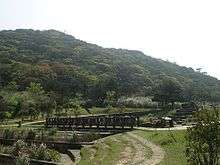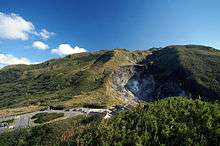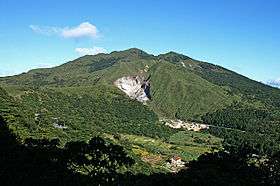Yangmingshan National Park
Yangmingshan National Park (陽明山國家公園); Yáng Míng Shān Guójiā Gōngyuán) is a collection of peaks in Taiwan, located to the northeast of Taipei.
Understand
Yangmingshan's original name was Caoshan (Grass Mountain in Mandarin), referring to the tall silvergrass that covers the highest slopes. Chiang Kai-shek renamed it Mount Yangming after his favorite Ming philosopher Wang Yang-ming (AD 1472-1529).
The tallest peak, Mount Qixing (Seven Star Mountain), has an elevation of 1,120 m (3,674 ft), and its peak is the highest point in Taipei City. Trails leading throughout the entire park consist of basalt pavers, are steep in places, and can be fairly treacherous during periods of rain. Expect to be passed by septuagenarian locals who make the trip every week!
Below approximately 1,000 m (3,280 ft), the park is characterized by subtropical rainforest, whereas above 1000 m, scrub-like trees and tall clumping grasses are the main form of vegetation.
Get in
Bus 260 leaves from Civic Blvd (outside Taipei Main Station) for the park every ten minutes, traveling along Zhongshan North Road, and turning right onto Zhongzheng Road in Shilin. From Jiantan MRT Station, Bus Red 5 leaves for the park every 15 minutes. From Beitou, bus 230 plies the route every thirty minutes. It is a short walk from the bus terminal station to the cultivated area of the park. The journey from Taipei Main Station takes about forty minutes and costs NT$30.
Mini-bus number 15 departs hourly from Beitou for Judz-hu (also spelled Zhuzi Hu - refer to See section below).
Fees and permits
There is no fee to enter the park.
Get around
By road
- The mountains are covered in a network of roads, and there are several mini-buses that leave from Zhongzheng Road (directly in front of exit 1 at Shilin MRT Station) that traverse the mountains.
- Public transport information is available online
- For NT$60, you can take the 108 bus around the park as often as you want during its operating hours (07:00 - 17:30). There are plenty of stops at various locations around the park, but you may have to wait 15 or 20 minutes between buses, so plan accordingly.
By foot
The mountains are connected by well maintained hiking trails.
See
- Azaleas, cherry blossoms every spring, in Yangming Park (Houshan Park).
- The panorama of Taipei (especially attractive at night) from an observation platform at the entrance to Zhuzi-hu (bamboo lake).
- The fumaroles at Xiaoyoukeng.
- The best grassland in Taipei, Qingtiangang. This area is popular with picnicking students and families.
- The Master of Humor - Lin Yutang (林語堂) was one of the well-known scholars in China and Taiwan. His former residence is one of the most popular tourist spots in Yangmingshan. The Lin Yutang House 's address: 141 Yangde Blvd Sec. 2. Open: 10:00 - 21:00.
- Yangming Shuwu, 12 Zhongxin Road. Also often called Yangming Villa, is an historical building built by former President Chiang Kai-shek for receiving foreign dignitaries.
Do
Hiking
The mountain peaks are accessible by a network of well maintained hiking trails.
- Tianmu Trail (天母古道), a pathway up the side of Yangmingshan from Tianmu (天母), the end of the Zhongshan North Road Sec. 7. The entrance is marked with a large signboard and map (in English). Up the trail about 1000-step stairway, you can see a historic water pipe line along the trail, built in 1940s. End of the steps, the trail becomes flat and comfortable, walk along in the forest and enjoy the clear air. Great! This trail is today one of Taipei's most popular day hiking destinations. You can take the MRT (Danshui line) to Zhishan Station and take the 220 bus from the intersection of Zhongshan North Rd and Zhongcheng Rd to the terminal station, then walk north up Zhongshan North Road past the circle about to the end of the road (about 5 minutes), and you can see the entrance with a large signboard.
- Lengshuikeng (冷水坑), contains Taiwan's sole bed of precipitated sulfur. Sulfurous fumes vented in the bed of this marshy lake turn the water murky. After gradually precipitating, the sulfur forms whitish-yellow or pale gray layers in the lake bed. Popularly known as Milk Lake, the lake is only approximately 40°C (104°F) in temperature, and not the 90°C (194°F) or more found in some hot springs. For the convenience of visitors who wish to wash and relax, there are two hot springs pools and one foot-soaking pool. When you are in Lengshuikeng, be sure to go to the observation platform on the northeast side to enjoy the beautiful scenery surrounding you. A milky white lake is below. This is the location of the explosion vent of Lengshuikeng. You will have a better view of it while walking down the trail from the Seven-Star Park to Lengshuikeng. The arrival of early spring in northern Taiwan is marked by the presence of migratory swallows. These can be seen behind the Lengshuikeng Visitor Center. Note that these birds eat on the wing. While on the ground they do not eat, but are busy gathering mud for nest building. There are two kinds of swallows in the Lengshuikeng area. The one with a snow-white belly is the summer migratory Barn Swallow, the other one with a brownish-gray belly is the resident Pacific Swallow. Due to the severe winter, they only appear in Lengshuikeng in the summer season to build their nests and breed. They are transit visitors.
- Qingtiangang (擎天崗), is a terrace formed by lava flowing to the north from Mt.Zhugao. This flat area is today an undulating grassland several kilometers across surrounded on all sides by mountain peaks higher than 800 m (2,624 ft) in elevation. The area was once used for grazing cattle under the administration of the Taipei City Agricultural Association, and private individuals could send their cattle to graze here, and popular with picnicking students and families.
 Erzihping
Erzihping - Jinbaoli Trail (魚路古道), was built long ago as a shortcut over the mountains of Yangmingshan, enabling deliveries of fish from the sea. Starting at Jinshan, the route passes Payen, Qingtienkang, and Zhishanyen before eventually reaching Shilin, Dalongdong, and Dadaocheng, where the fish were sold in local markets. It is also known as the "Old Fish Trail". Still in good condition, the trail is surrounded by old cultural sites and splendid natural scenery. Walking the trail allows one to really appreciate the spirit of the long-ago Chinese settlers who opened up Taiwan.
- Erzihping Trail (二子坪步道), facilities in the recreation area include a 1,700 m-long (5,577 ft) obstacle-free trail, trail explanations, a wooden plank path, an ecological pond, explanation boards, gazebos, picnic benches and chairs, public toilets, and free wheelchair and baby trolley borrowing service. Opening hours of the obstacle-free trail: 8AM-6PM. Unauthorized vehicles are not allowed to enter the Erzihping area. No bicycles or motorcycles are allowed in the area.

- Xiaoyukeng (小油坑) is the best-known recreation area in Yangmingshan National Park, and offers some of the most typical scenery. Located above the Datong Bridge along the Yangmingshan-Jinshan Highway, Xiaoyukeng is at an elevation of 800 m (2,624 ft) and contains a host of volcanically-created fumaroles, sulfur crystals, hot springs, and landslides. Sulfur vents noisily spew forth gases, and hot springs discharge endless streams of boiling water. The bright yellow sulfur crystals that can be seen here are exceptionally lovely. Mt. Cising provides breathtaking views in all directions.

- Mt. Cising (Qixing) (七星山), is the highest peak in the Datun Volcano Group. Because Mt. Cising's main and subordinate peaks are in the form of the Chinese character for "mountain," it is especially majestic and easy to recognize. Located in the center of Yangmingshan National Park, Mt. Cising is the highest peak in the administrative area of Taipei City. Cising Park is to the south of the mountain's eastern summit. This park contains four pavilions of different sizes, plus stone tables and chairs. It is a popular rest stop for people climbing Mt. Cising. Trails lead from Cising Park to Menghuan Lake, Lengshuikeng, and the eastern and main summits of Mt. Cising.
- Mt. Datun (大屯山), is a volcanic basin popularly known as Datun Nature Park. It is defined as an area in the western section of Yangmingshan National Park, extending from Mt. Datun northward to Mt. Tsaikungkang. Located on a broad saddle between two mountains, the area contains the marshy Datun Pond. Wooden boardwalks around the pond makes it convenient for visitors to see the scenery and lush aquatic vegetation. The area includes an azalea restoration area where the spectacular blossoms of various kinds of rhododendron and azaleas can be seen in the spring.
A particular interesting route is the following:
- 🌍
(blue) – Distance: 8.1 km, hilly. Altitude range: 554 m. Duration: 2-4 hr, depending on the side tours, time spent at the hot springs (opening times see below) and personal fitness for climbing the 550 m altitude. Grade: Medium. Recommended: comfortable clothes and boots for walking.
This trail covers most of the above mentioned scenic sights, like Mt. Cising (Qixing), Lengshuikeng (hot springs), Xiaoyukeng (sulphur area), the Juansi Fall, and an optional side tour to Qingtiangang (grasslands).
From Taipei take the metro (red line) to MRT Shilin Station (Zhong Zheng). From there take bus no. R15 to Juan Si Waterfall to the start of the track, where the bus lets of all passengers and turns off left. Note, apparently 1 in 3 buses go further. At the northern end of this track take bus no. 1717 back into Taipei. Btw. reversing the track will save you some of the hiking.
Download track: KMZ, GeoJSON, for GPX see GPSies.
Hot springs
Soak in sulphur hot spring baths - Yangmingshan is dotted with hot spring resorts. There are also a few free baths maintained by the city government.
- 🌍 Lengshuikeng Public Baths. Daily: 06:00-09:00, 10:30-13:00, 14:30-17:00, 18:30-21:00. Closed every first Monday of the months and a few Tuesdays per year. Nude, men and women in separate buildings. Make sure to bring your own soap and wash cloth. The rules insist that you much pre-wash before entering the smallish 40°C tub, and the attendees will insist too. Not many foreigners find this place, so if one, be ready to intimately meet the locals. Free.
Relax
Yangmingshan is all about relaxation and recuperation. It is the first place Taipei citizens think of when stressed out or feeling run down. Fill your lungs full of fresh mountain air, let your eyes rest on miles of lush green hills, and let your body melt away in a milky sulphur bath.
Eat
Mid-range
- Lavander Garden, ☎ +886 2 28737581. This vegetarian restaurant is in Tianmu directly at the base of the Tianmu trail. Good place to go when starting on a hike up or to relax when finishing a hike down.
Splurge
- Shiyang Culture Restaurant (食養山房餐廳), 160 Lane 101 Jinshan Road, ☎ +886 2 2862-0078. Taipei's classiest creative cuisine, near Lengshuikeng area.
Sleep
Budget
- International Hotel (國際大旅館), 7 Hushan Road Sec. 1, ☎ +886 2-2861-7100. An old hot spring hotel in Yangmingshan since 1952. Many rooms have tatami, Japanese style floor.
Splurge
- Landis Resort Yangmingshan (陽明山中國麗緻飯店), 237 Gezhi Road (Near the Chinese Culture University.), ☎ +886 2-2861-6661. Hot spring soaking pool and swimming pool are the best.
Stay safe
- Besides beautiful scenery, Yangmingshan is also famous for its venomous snakes. Don't go wandering off into scrub land.
- People with high blood pressure, heart disease or open wounds should not enter the hot springs.
Respect
- It is illegal to pick flowers.
- It is illegal to kill or disturb wild-life.
- Obviously, don't litter.
- Public hot spring etiquette requires that bathers thoroughly wash and rinse off their bodies before entering the bath, do not wear clothing (including swim wear) in some of the baths, and tie up their hair so that it does not touch the water.